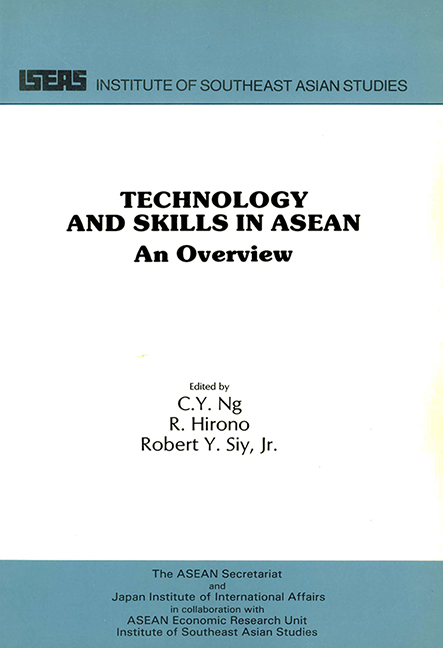Book contents
- Frontmatter
- Contents
- Foreword
- Preface
- PART ONE ASEAN OVERVIEW
- PART TWO SECTION 1: JAPANESE OVERVIEW
- 1 Industrialization, Technology Transfer and Skills Enhancement in Asean: A Japanese View
- 2 Major Issues of Technology Transfer, Adaptation, Diffusion, and Development, and Skills Enhancement
- 3 Technology Transfer and Development in Asean: Machinery and Electronics Industries
- 4 Regional and International Arrangements For Technology Transfer
- 5 Conclusions and Recommendations
- PART TWO SECTION 2: JAPANESE EXPERIENCES IN TECHNOLOGY TRANSFER
- The Editors
5 - Conclusions and Recommendations
from PART TWO - SECTION 1: JAPANESE OVERVIEW
Published online by Cambridge University Press: 09 November 2017
- Frontmatter
- Contents
- Foreword
- Preface
- PART ONE ASEAN OVERVIEW
- PART TWO SECTION 1: JAPANESE OVERVIEW
- 1 Industrialization, Technology Transfer and Skills Enhancement in Asean: A Japanese View
- 2 Major Issues of Technology Transfer, Adaptation, Diffusion, and Development, and Skills Enhancement
- 3 Technology Transfer and Development in Asean: Machinery and Electronics Industries
- 4 Regional and International Arrangements For Technology Transfer
- 5 Conclusions and Recommendations
- PART TWO SECTION 2: JAPANESE EXPERIENCES IN TECHNOLOGY TRANSFER
- The Editors
Summary
All six ASEAN countries have exhibited, to varying extents and over different time periods, high rates of economic growth during the last two and a half decades. With the exception of Brunei which only a year ago gained political independence and became a member of the regional grouping, the ASEAN countries launched their respective industrialization programmes during the early to mid-1960s to propel economic growth, restructure national economies, expand employment, and eventually raise the level of living.
In launching their industrialization programmes, the ASEAN countries adopted liberal economic policies, opening their doors to private foreign investors to accelerate the inflows of capital, technology and management know-how and to have access to far bigger and expanding markets overseas, particularly in the industrial countries. For various reasons, investors in the United States, the European Community and Japan found the ASEAN region quite attractive and expanded their manufacturing operations there.
To accelerate foreign investment and technology inflows, various incentive schemes were installed by the governments of the region, in addition to their sustained efforts to maintain political stability and attractive economic climates. Corporate income taxes were exempted for a period of five years or more and import-duty reductions/exemptions were introduced when pioneer/promoted firms were purchasing plant, machinery, equipment, or industrial materials from overseas. Low-interest loans were also provided by governmental or semigovernmental financial institutions to enable those firms to be more productive and competitive on the market. Additional incentives were later brought in to encourage greater inflows of foreign manufacturing investments and technologies and to promote R&D activities which were considered essential to their further industrialization.
Partly due to the relative factor endowments and partly to the import-substitution strategy of the ASEAN governments, manufacturing investments in the early phase of their industrialization programmes, both domestic and foreign, were mainly in the consumer goods sector, catering to the needs of the middle-to upper-income population.
- Type
- Chapter
- Information
- Technology and Skills in ASEANAn Overview, pp. 125 - 132Publisher: ISEAS–Yusof Ishak InstitutePrint publication year: 1988

